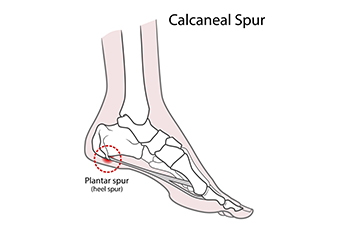
Heel spurs are bony outgrowths on the calcaneus bone of the foot. They may cause chronic pain and discomfort as they gradually develop, although in some cases no symptoms are felt. Heel spurs are often associated with local inflammation in the foot's soft tissues or fascia. They can appear under the heel, at the back of the heel, or beneath the sole of the foot. Causes of heel spurs can include muscle strain, excessive stretching of the plantar fascia, and tearing of the heel bone's covering membrane. At risk of developing heel spurs, are people who run or jog frequently on hard surfaces, wear ill fitting shoes that lack arch support. Additionally, heel spurts may develop in people who are overweight, or exhibit abnormal gait patterns that stress the heel region. A common symptom of a heel spur is intermittent pain during activities such as walking or running. Other symptoms include inflammation, a pin-sticking sensation at the bottom of the foot while standing, and discomfort after being at rest. Treatment options focus on pain management, along with wearing proper footwear, and, in severe cases, surgery to remove the spur. If you believe you may have developed a heel spur, it is suggested that you make an appointment with a podiatrist for a precise diagnosis and treatment options.
Heel spurs can be incredibly painful and sometimes may make you unable to participate in physical activities. To get medical care for your heel spurs, contact our podiatrists from CNY Foot Surgery & Podiatry Care. Our doctors will do everything possible to treat your condition.
Heels Spurs
Heel spurs are formed by calcium deposits on the back of the foot where the heel is. This can also be caused by small fragments of bone breaking off one section of the foot, attaching onto the back of the foot. Heel spurs can also be bone growth on the back of the foot and may grow in the direction of the arch of the foot.
Older individuals usually suffer from heel spurs and pain sometimes intensifies with age. One of the main condition's spurs are related to is plantar fasciitis.
Pain
The pain associated with spurs is often because of weight placed on the feet. When someone is walking, their entire weight is concentrated on the feet. Bone spurs then have the tendency to affect other bones and tissues around the foot. As the pain continues, the feet will become tender and sensitive over time.
Treatments
There are many ways to treat heel spurs. If one is suffering from heel spurs in conjunction with pain, there are several methods for healing. Medication, surgery, and herbal care are some options.
If you have any questions feel free to contact our office located in East Syracuse, NY . We offer the latest in diagnostic and treatment technology to meet your needs.



